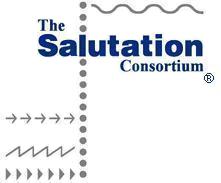
Introduction to Open Source
|
|
Introduction to Open Source |
Excerpts form http://www.opensource.org/
with added commentary relative to Salutation Consortium in italics.
Open source promotes software reliability and quality by
supporting independent peer review and rapid evolution of source code.
An important side effect of the
open-source model is a much wider platform range for your product. Open-source
authors frequently find themselves
receiving, for free, port changes for operating systems and environments they
barely know exist and can't afford developers to support. Each such port, of
course, widens the market appeal of the product.
The basic idea behind open source is very simple. When programmers can read, redistribute, and modify the source for a piece of software, it evolves. People improve it, people adapt it, and people fix bugs. And this can happen at a speed that, if one is used to the slow pace of conventional software development, seems astonishing.
Additionally, people add it to their product mix, enhancing its functionality and deploying products and services in a broad range of markets. This propagates the initial open source to additional products and services, increasing the opportunities for all concerned.
Computer programs have three kinds of economic value.
Use value -- economic value as a tool,
Market value -- saleable commodity, and
Monopoly value -- unavailable to your competitors.
The broader distribution of open-source code creates additional value in the client/server market, as new clients will be developed to use existing services.
For Salutation, this means potential development of new products and services that can access existing Salutation-enabled MFPs and Fax devices. Salutation open source does not displace existing products but creates new markets for them. It provides a readily available tool for Salutation-enablement.
Probably the purest demonstration today is Red Hat, which has built a flourishing business selling software you can download for free from Red Hat's own web site! Red Hat's sales are doubling every year. What you're really buying from them is handholding and support for the ``free'' stuff they sell - a single place to go when you have problems.
For Salutation, the proposed freeEstuff E the Salutation Manger -- is surrounded by services and functions provided by the product/service providers. Here, what youre really buying is the derivative works added to the Salutation technology that provide solutions for the target market.
Adopting or even just studying someone else's software is not a costless, frictionless process; you need to dedicate skilled time to it. As product cycle times drop, coattail-riding gets less attractive, because the payoff period shrinks relative to the time you had to dedicate. And time your skilled people spend studying someone else's "monopoly" code is time you're spending getting to where the competition used to be (rather than where they are now).
For Salutation, our model of openness is the opposite of the monopolyE Open source breaks the dependence on one or a few suppliers and enables would-be supporters to get to a solution quickly and in a way that is assured to be current and compliant.
Beyond all the reliability and quality gains we've discussed elsewhere, the open-source model has one overwhelming advantage for the software customer: you aren't a prisoner. Because you can get access to source, you can survive the collapse of your vendor. You're no longer totally at the mercy of unfixed bugs. You're not shackled to every strategic decision your vendor makes. And if your vendor's support fees become exorbitant, you can buy support from elsewhere.
For this reason alone, every software customer should absolutely demand open source and refuse to deal with software vendors who close and shroud their code. It's a matter of controlling your own destiny.
For Salutation, this goes back to our formation; providing the industry with an open architecture definition that enables each manufacturer to follow its own business model for building networked products and services. We have created the architecture, -- open source for a reference implementation is the next logical step in assuring our freedom of action.